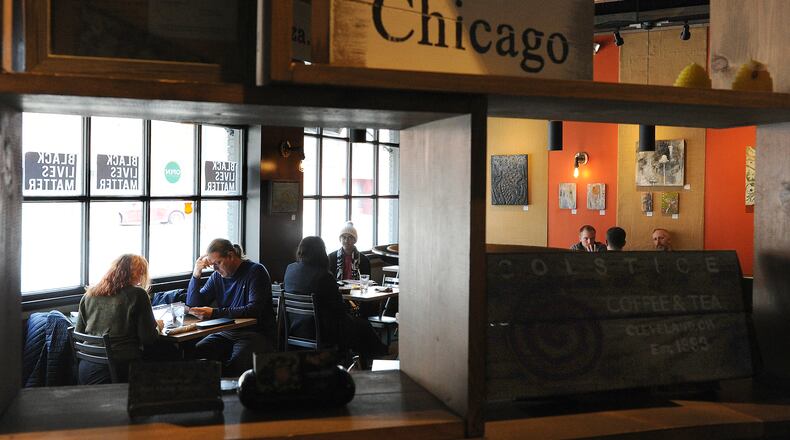The association said in recent weeks:
• 57% reduced hours of operation on days they are open;
• 34% closed on days they would normally be open;
• 18% reduced seating capacity;
• and 9% changed to only offering off-premise dining for a period of time.
John Barker, president and CEO of the Ohio Restaurant Association, said a survey of Ohio operators shows the omicron variant led to a rapid deterioration in restaurant business conditions in late December and so far in January.
“All signals for our industry are red, with declining customer traffic, soaring inflation for food and supplies, and ongoing pressure on employee shortages,” Barker said. “This is on top of a 22-month rollercoaster for our industry that resulted in more than 3,150 restaurants closing in our state.”
Credit: JIM NOELER
Credit: JIM NOELER
Emily Mendenhall, owner of Lily’s Dayton in the Oregon District, has been working on table tents to be placed on the restaurant tables, with information on what people can do to help local restaurants during this time.
With big challenges to morale, she said one key step customers can take is to treat restaurant employees well, and to take time to post positive reviews for favorite local places.
“Those kind words go a long way, both in helping bring in other customers, but also in helping the people working in these places feel seen and feel appreciated, when they have maybe not felt great for an extended period of time,” Mendenhall said.
She said it is important for customers to adjust their expectations and be patient, because some places might be short staffed, short supplied and stretched thin. The pandemic has shown how critical it is for workers to stay home when sick, she said, but that means customers need to shift expectations for days when a restaurant is operating with a small crew.
Mendenhall said another change that will help locally owned restaurants survive is for customers to accept paying a little more for dining out, as supply costs go up and as restaurants raise wages and improve conditions.
“If we want to pay fair wages, our customers need to be willing to pay the price that allows us to do that,” she said.
Credit: JIM NOELER
Credit: JIM NOELER
The Ohio Restaurant Association is pushing for more money to be added to the Restaurant Revitalization Fund, which helped bail out many local restaurants earlier in the pandemic.
Established through the American Rescue Plan Act in the spring of 2021, the fund is a $28.6 billion federal grant program administered by the U.S. Small Business Administration.
In Ohio, 97% of fund recipients said the grant made it more likely that they would be able to stay in business during the pandemic and 72% said the grant helped them retain or hire back employees that would otherwise have been temporarily or permanently laid off.
“The National Restaurant Association and ORA are calling on Congress to pass the RRF Replenishment Act to help restaurants weather the winter and survive,” said Barker.
By the numbers: Ohio’s restaurant recovery
64% of operators say their sales volume in 2021 was lower than it was in 2019.
Only 27% of operators reported a same-store sales increase between 2019 and 2021.
Much of the sales growth in 2021 was driven by higher menu prices, as restaurant operators were forced to offset sharply rising costs throughout their restaurant.
83% of operators say their restaurant’s total costs (as a percentage of sales) were higher in December 2021 than they were in December 2020.
Only 8% of operators reported lower costs.
Source: Ohio Restaurant Association
About the Author



